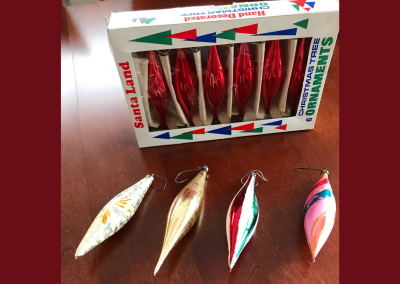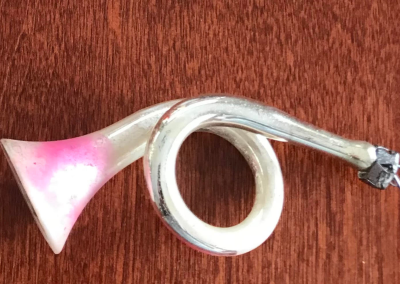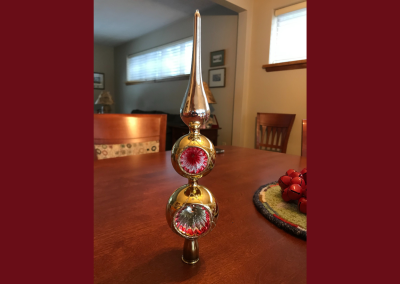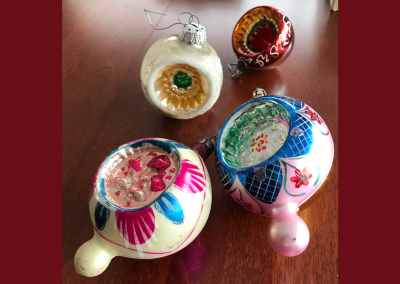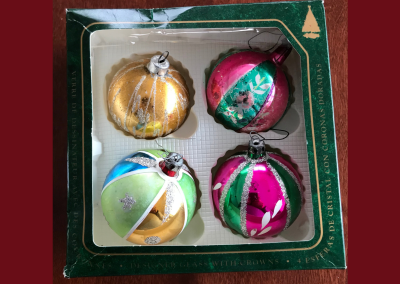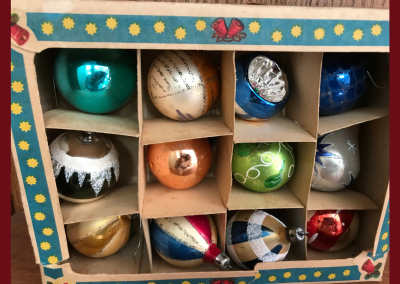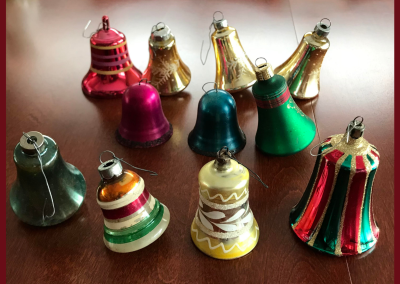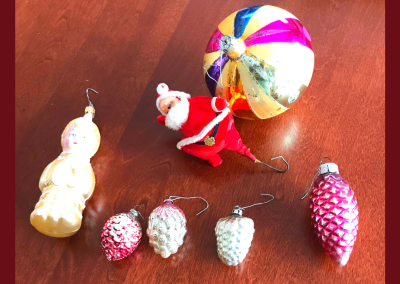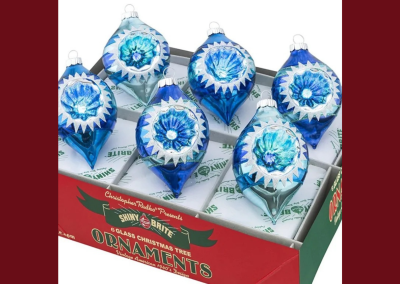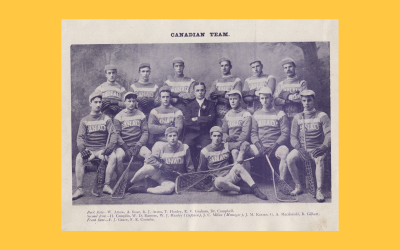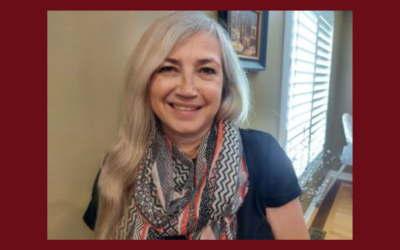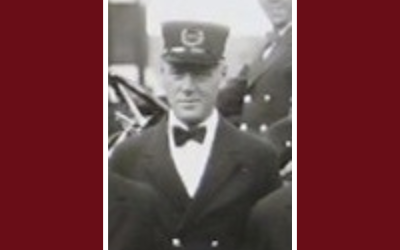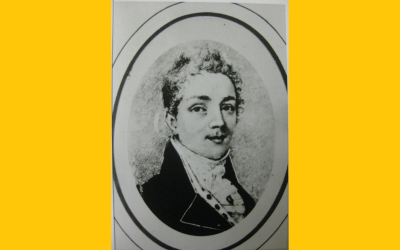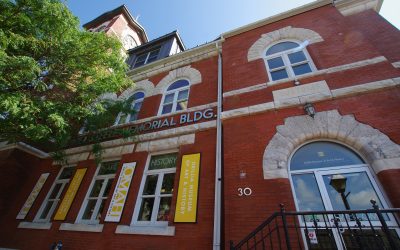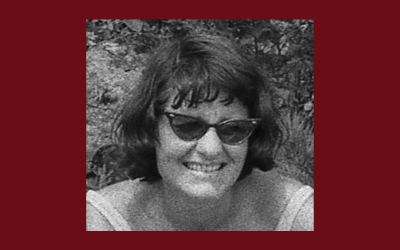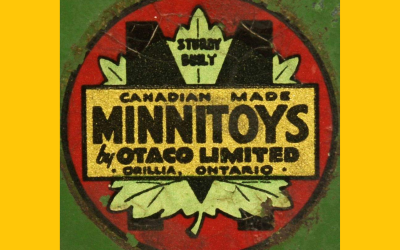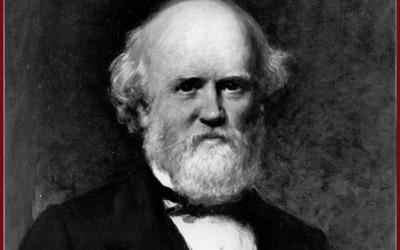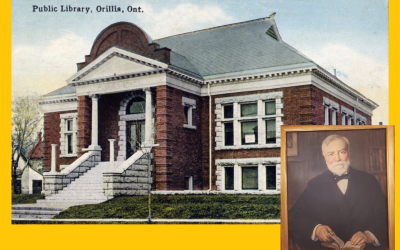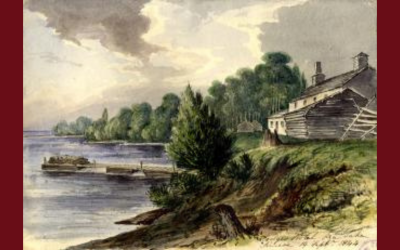Ornaments from Christmases Past
By Mary Ann Grant
Years ago, this writer became a collector of old-fashioned ornaments that fell out of favour with the advent of plastic. Whether antique, vintage or reproduction, they are precious for their beauty and unique design. They are not just the red and green colours associated with Christmas, but all the colours of the rainbow. These unique ornaments were purchased for pennies at antique stores, yard sales, estate sales and church bazaars in Orillia. They were used by our parents or grandparents, and evoke memories of long-ago days. They tell a story of bygone times.
Their Origin
The tradition of decorating a tree for Christmas originated in Germany. They used fruits and nuts to decorate trees that had shed their leaves to symbolize the spring that was to come. In the early 1600s the trees were brought inside and candles and paper roses were added.
In the 1800s German immigrants brought their tradition to North America and used whatever was available to them to decorate the trees, such as strings of popcorn and cranberries, candles and fruit.
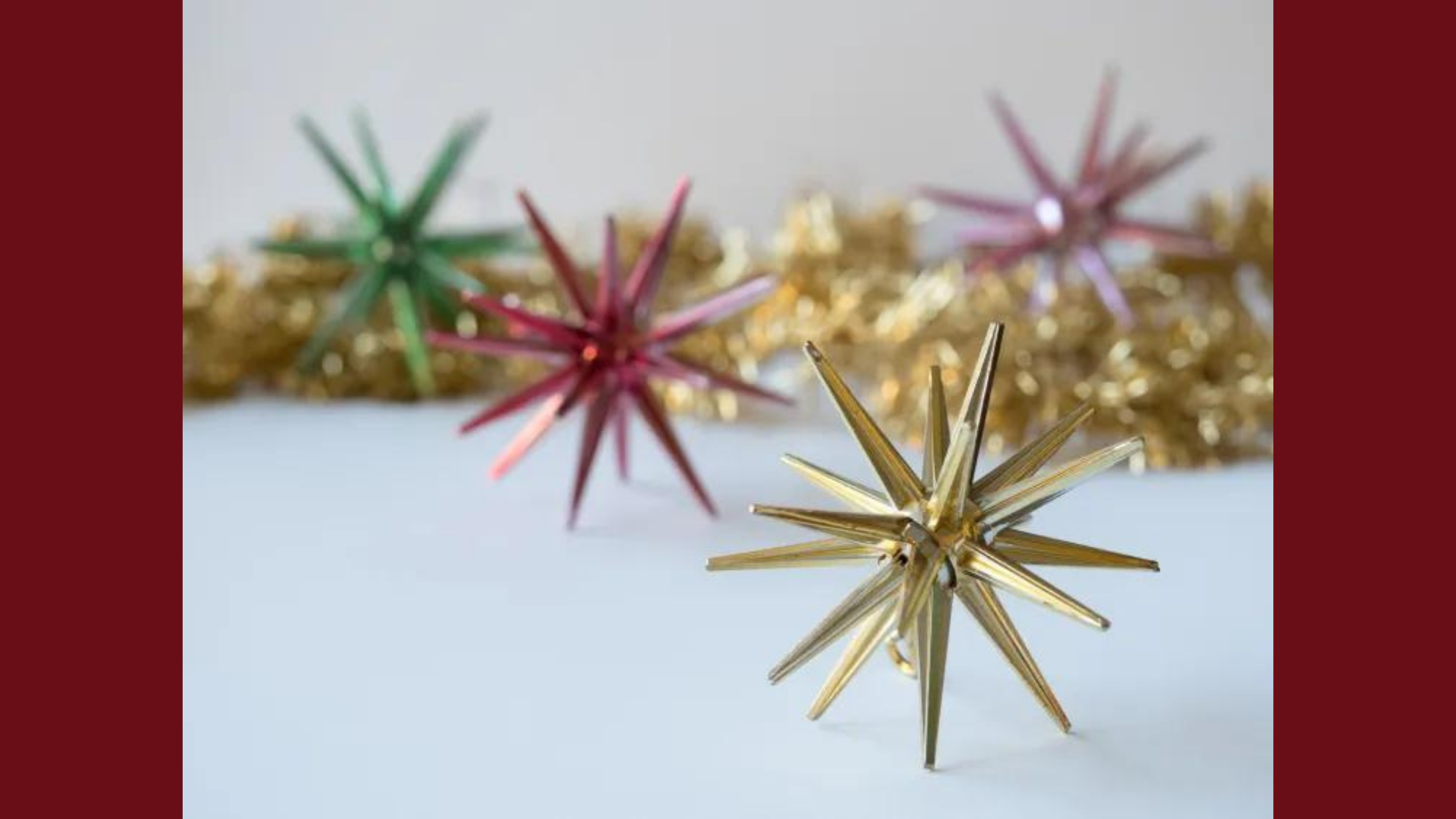
The glass ball ornament came to be and evolved into different shapes, bells, angels, fruit, musical instruments like horns, animals, trees, icicles and lanterns to name a few. Even an ornament modelled on the Russian ‘Sputnik’, the first artificial satellite to be launched into orbit by the Soviets on October 4, 1957, was created.
The origin of the ornaments can usually be found on their cap. This writer’s ornaments originated from the USA, Germany, Poland, Czechoslovakia and other countries. Some are made of metal; others are blown glass and bottle brush.
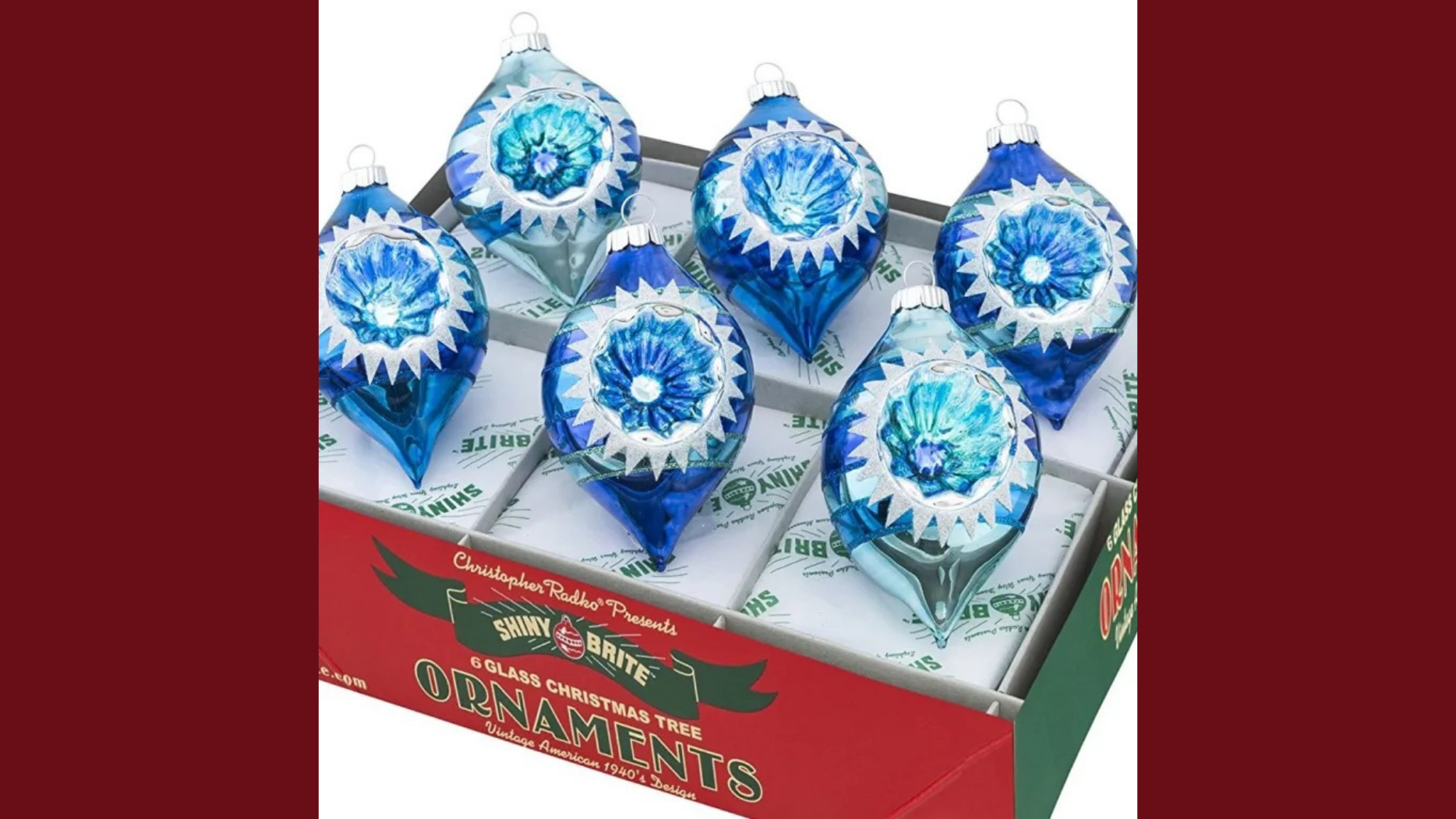
The invention of Shiny Brite Christmas ornaments in the United States came as a result of World War Two, which made it difficult to import ornaments. American businessman Max Eckart, who had been importing the ornaments from Germany since 1907, made a plan to avoid disruption in his business. He knew that glassblowers from many European countries were employed by Corning Glass and Corning held the patent for the glassblowing machine that was used for the manufacture of lightbulbs. Eckart convinced Corning to make a few alterations to the glassblowing machine to make ornaments. By 1940, Corning Glass was producing 300,000 ornaments per day. Most were sold to Eckart’s Shiny Brite company. Woolworths was a big distributor for the ornaments.
When metal paints and varnishes were in short supply because of the war effort, the balls were banded with slim lines in light shades. The glimmering tops normally made with metal were replaced with hangars made from folded cardboard. After the war the ornaments were again decorated with vibrant colours and metal caps were used again. With the ornaments falling out of favour, Shiny Brite ceased production.
The collection of the old ornaments has made a resurgence. In fact, Christopher Radko purchased the right to use the Shiny Brite name and in 2001 started making authentic looking reproductions of the ornaments.
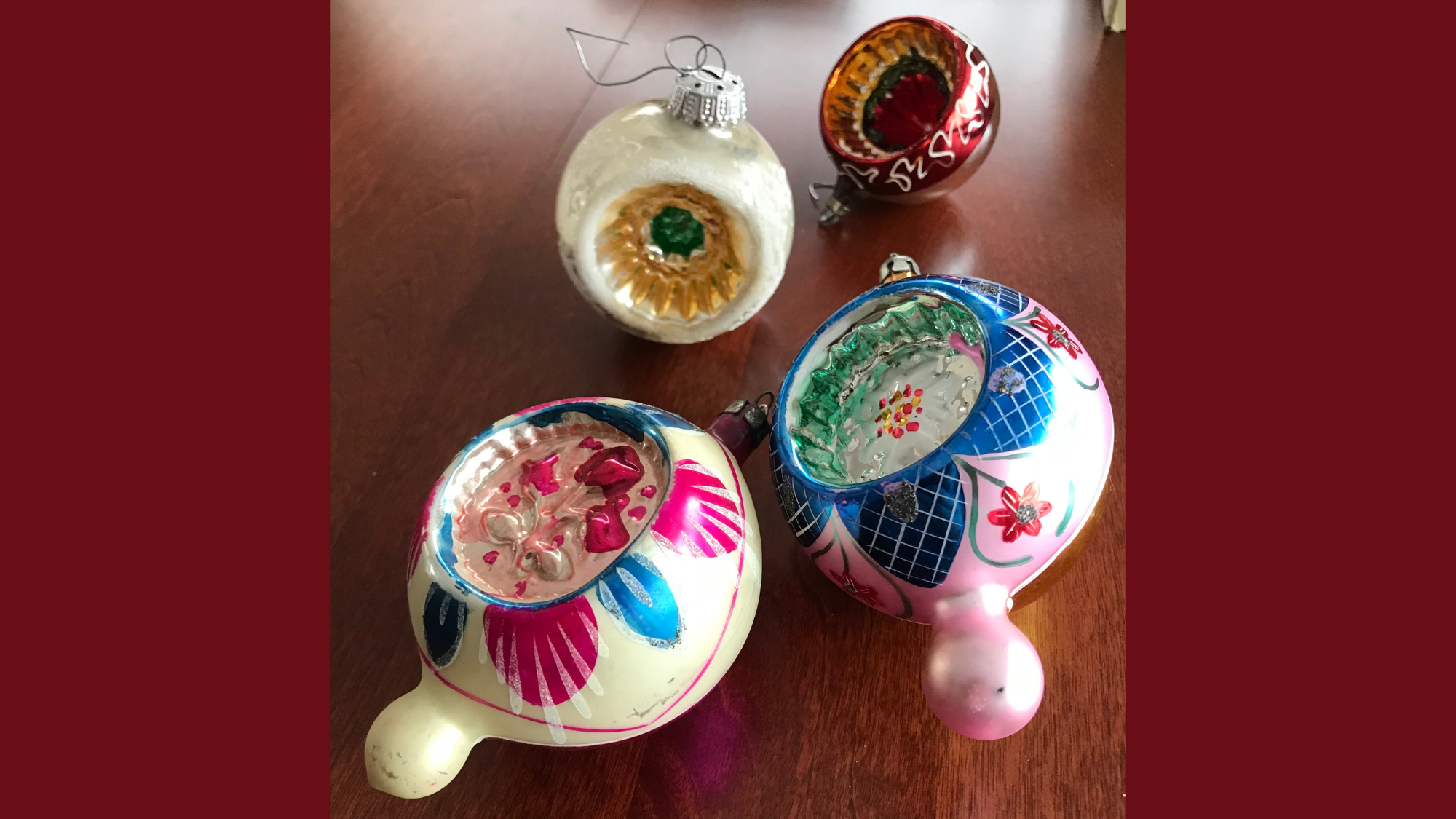
A Facebook group called The Golden Glow of Christmas Past is a forum for enthusiasts who are passionate about preserving and learning more about our Christmas history. Click on the HERE if you are interested in following this group.
It is wonderful that these pieces of beautifully designed ornaments are being preserved for future generations.
With Thanks to:
- Vintage Christmas Ornaments
- Christmas HQ – Christmas Ornaments, Their Origins, History and Meaning by Kathryn Mars
- Shiny Brite Ornaments: The History of a Holiday Classic
- CBC Vintage Christmas – Ornaments and How to Collect Them
- RUG HOOKING MAGAZINE – Vintage Ornaments Nov/Dec 2020
THE CANADA-AUSTRALIA SERIES
By David TownIt was another proud first for Orillia, and an astounding accomplishment – but as John Miller stepped off the train at the Orillia platform the only people there to greet him were his family. He had single-handedly negotiated, organized, and managed the...
2022 Year-end Message from the OMAH History Committee
by Trish Crowe-Grande, Chair, OMAH History Committee While this past year saw COVID-19 restrictions ease, the OMAH History Committee listened to its audience and continued to offer its popular History Speaker Series as well as the Annual Carmichael Art History...
MASSEY FAMILY HOME CHILDREN OF CANADA
Albert (Bert) Scaife Massey – OMAH CollectionBy Fred Blair, OMAH History CommitteeIn 1868, Anne Elizabeth Massey was born in Chelsea, London, England. She was the daughter of George and Elizabeth Massey. By 1891, the family had moved to Fulham, London and “Annie”,...
Elmes Yelverton Steele and the Napoleonic Wars
By Fred Blair OMAH History CommitteeIn 1798, Elmes Yelverton Steele joined the Royal Navy in England as an officer cadet. In 1799, the British acquired intelligence that Napoleon had commissioned four Spanish vessels to transport over twelve million pounds sterling...
THE HISTORY OF OMAH’S CLOCKTOWER
By Mary Ann Grant – OMAH History CommitteeWhat’s going on?? If you have been by OMAH recently you will have noticed the scaffolding installed on the building and the work underway. The Sir Sam Steele Memorial Building, specifically the clock tower, is getting some...
WENDY HUTCHINGS – TRIBUTE
Wendy Hutchings – Tribute by Mary Ann Grant - OMAH History Committee The Orillia Museum of Art & History believes that it is important to acknowledge its supporters, those who have made a contribution to the culture of our community and to keeping our local...
Brief History of OTACO
R.W. Phelps was born on January 14, 1888 in Iowa. He ultimately graduated as an Industrial Engineer. Early in his career he caught the attention of A.G. Bush who had a small company that manufactured one-cylinder engines that were used for farm and industrial...
John Ramsay and the Oro Settlers from Islay
By Fred Blair, OMAH History Committee John Ramsay grew up in Glasgow, Scotland. In 1836, at the age of 22, he obtained a lease on the struggling Port Ellen whisky distillery on the Island of Islay in Argyllshire, Scotland. In order to export whisky to the United...
Our Carnegie Library
By Mary Ann Grant, OMAH History Committee Did you know that Orillia’s first official Public Library was a gift from American philanthropist Andrew Carnegie? Andrew Carnegie was responsible for funding the building of libraries worldwide. The extent of the benefits...
HODGES’ LANDING: A BRIEF HISTORY
By Fred Blair The “Historic Hawkestone” plaque, located at 375 11th Line South, Hawkestone, recorded that “Richard Hodges established a landing for settlers” on Lake Simcoe in the 1830s in the community that is now known as Hawkestone. However, land records indicate...

